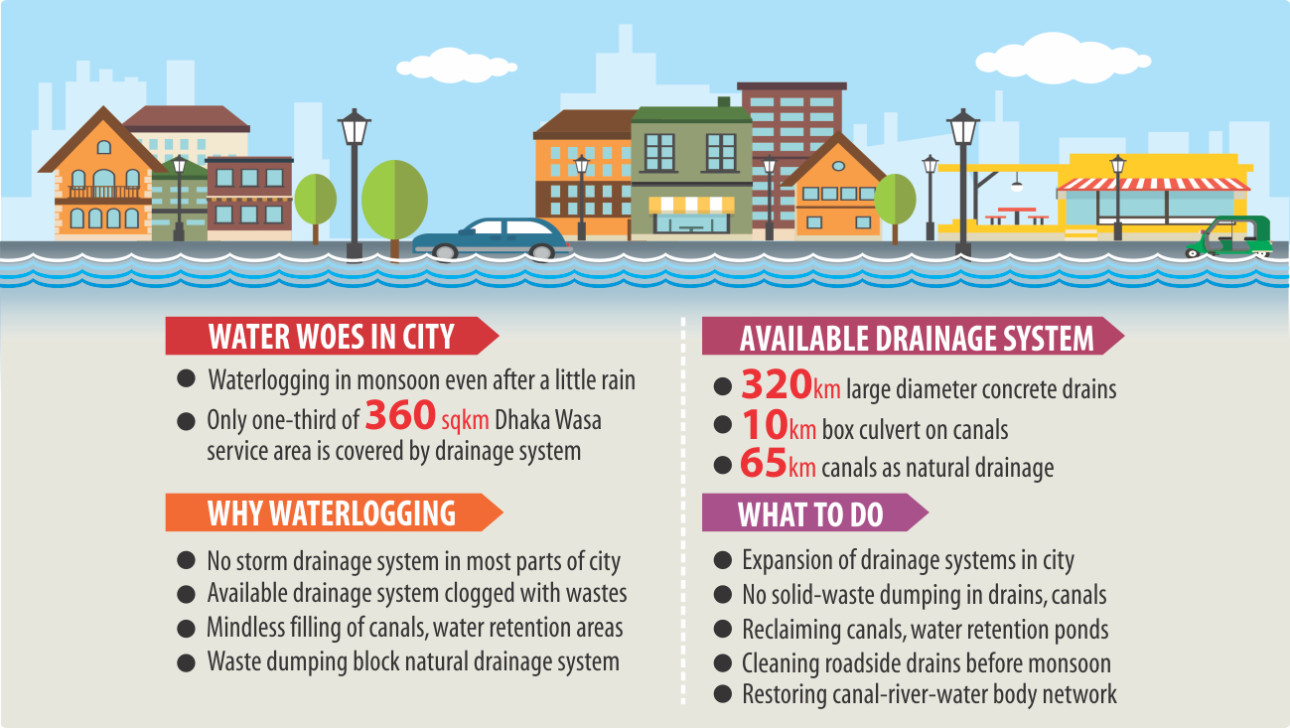
Life in Dhaka city virtually comes to a standstill every time there is a monsoon rain. Many areas go under water due to scanty storm drainage system and the indiscriminate filling up of water retention areas by private and government entities over the years.
Shantinagar, Khilgaon, Bashabo, Malibagh, Shantibagh, Rajarbagh, Mughdah, Mohammadpur, Badda and different parts of Old Dhaka are among the areas that experience the worst of waterlogging after a shower.
Just a third of the 360-square kilometre Wasa service area is covered by storm-water drainage system. The Dhaka master plan area, however, is 1,528 sq km, officials said.
Wasa has a storm-water drainage system master plan for the capital, but its implementation will depend on the availability of funds, they added.
Canals, rivers and water retention areas collect, carry and retain rainwater and are connected with each other as a drainage network. But in recent decades, the city canals have either been grabbed or turned into box culverts for road construction, said Khondaker M Ansar Hossain, an urban planner who worked as a technical expert on Detailed Area Plan (DAP) for Dhaka.
The government had ignored repeated warnings of experts not to allow water retention areas and flood flow zones to be used for housing estates in the DAP, he said.
Open space and water bodies help evaporate a third of the rainwater, percolate another third while leaving the rest to run down to retention areas, Ansar said. But in the absence of those, water gets stuck on the city roads and takes hours to recede even after a light rain.
City dwellers are left to suffer for hours and sometimes days from almost stagnant water filled with filth. Traffic becomes a nightmare with vehicles breaking down in the water.
According to the Flood Action Plan and DAP, the city should have conserved 5,523 acres of water retention area (which is only 1.57 percent of the 1,528sqkm of Dhaka’s master plan), 20,093 acres of canals and rivers (5.7 percent) and 74,598 acres (21 percent) flood flow zones.
“Since DAP gazette notification in mid-2010, nearly all of the conservable wetlands have been filled up with silent government approbation,” Ansar said.
He said designated water retention areas on the eastern fringe (like east of Santarkul near the Balu river) have been filled up by private housing developers, in Uttara third phase housing scheme by Rajuk and private developers, and in Mohammadpur by private developers.
In the name of development that was ill-planned and insensitive to the environment, the ponds, ditches, playgrounds, parks, water retention areas, flood flow zones and dozens of canals, which used to work as natural storm-water drainage system connecting the four Dhaka rivers, have been ruined.
Ishrat Islam, professor and head of the urban and regional planning department at Buet, echoed Ansar’s view and said rainwater stagnation was increasing due to indiscriminate urbanisation.
She said the artificial storm-water drainage system was not only meagre, it remained clogged with solid wastes reducing its functionality and aggravating the waterlogging situation.
According to Taqsem A Khan, managing director of Dhaka Water Supply and Sewerage Authority (Wasa), filling up of floodplains, wetlands and most of the 65 canals in Dhaka was the main reason for waterlogging.
Wasa maintains 320km of large-diameter concrete storm-water drains, 10kms of box culverts over canals and 65km of canals for the city’s storm-water drainage management. This covers only a third of its area, said Taqsem.
KS Ching, superintendent engineer of Wasa drainage department, said they managed 26 city canals for storm-water drainage but most of those remained clogged with solid wastes of households and commercial establishments.
The areas, where there is no formal storm-water drainage system, have to depend on natural systems like canals and wetlands. Severe stagnation would be inevitable if those canals and low-lying wetlands are filled up, he said.
Wasa in 2012 installed large diameter storm-water drainage lines only in some parts of Gulshan, Dhanmondi, Mirpur Darussalam Road and Uttara.
Wasa superintendent engineer Akhtaruzzaman, who was the project director of the Tk 47-crore scheme for Gulshan, said it was a piecemeal measure and had not ensured complete storm-water drainage.
At present, a rainfall above 40mm in Dhaka would take at least three hours to recede, as the available system is capable of draining water of only 20mm of rainfall without causing too much public suffering, he said.
The city corporation authorities have to ensure that before monsoon their roadside drains are clear, including the water catch pit of storm-water drains, Akhtaruzzaman added.
Sirajul Islam, chief town planner of Dhaka South City Corporation, said the north and the south city corporations maintained over 2,000km feeder drains (open and small diameter pipes) to drain water from homes and rainwater and take them to canals and wide diameter (Wasa) storm sewer system.
Since population density is very high and the drainage capacity poor, rainwater takes hours to recede, he said.
Source: The Daily Star









